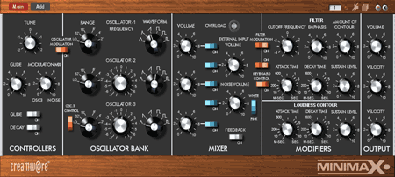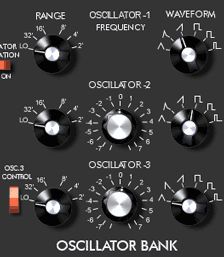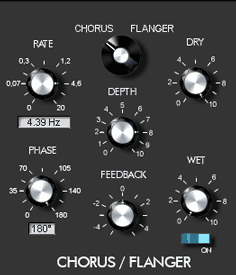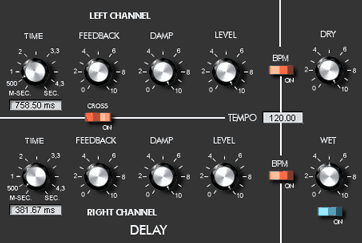|
Review: Creamware Minimax
By Manuel
Clement
(January 05, 2004)
 Back to the
Articles list Back to the
Articles list
Product: Minimax, digital analog synthesizer for the Creamware
DSP platform
Manufacturer: Creamware
Price: 249 EUR

Creamware,
well known for their DSP-based SCOPE Fusion Platform are coming up
with some really cool new devices these days. Today I am looking at
Minimax, which is said to be the first 1 to 1 emulation of Moog's
Minimoog classic synthesizer. Creamware says "it is the
instrument". Both of their systems, NOAH and SCOPE cards, are
powered by a set of dedicated SHARC DSPs (Digital Signal
Processors). Developers can build completely new ways of using the
hardware underneath. There is a very informative discussion posted on PlanetZ (THE
site for Creamware users - big hey to John who does a great job at
running it) where you will find more details about the different
advantages of dedicated DSP-based systems over CPU-only.
I
should also point out that users who got their Pulsar card 4 or 5
years ago (I am getting close to that) are still able to upgrade
their software, and use all the brand new devices such as the
Minimax, and their new interface for quickly wiring up your studio:
Live Bar. Minimax is available for the various systems of the SCOPE
Fusion Platform as well as for the new hardware synthesizer
Noah.
If you want to find out more about the Minimoog you should
visit this great page which has a ton of great info
including a list of some of the artists who have used the
minimoog (impressive).
Installation and Documentation
I logged to the user area
on Creamware's website, and downloaded the Minimax setup file. I
like how they keep all the software you own listed there in one
place, available for download at any time. The file I downloaded had
an unusual extension (.oxe) and was less than 700 KB in size. There
was no icon on the file an even though it wasn't clear that
double-clicking on the file would do anything as there was no icon
assigned to it (I would have expected a Creamware icon), the
installation worked. I was able to see Minimax available to insert
inside my projects after restarting the SFP (Scope Fusion Platform)
software.
The only problem I have with this package is that it
does not install any documentation. I had to go back to the
Creamware website to find a PDF file I could download and run
outside of SFP. There is a way to launch the documentation from
within the SFP software, however you have to copy the PDF file
somewhere in a particular folder and I would have liked an option to
download both a regular PDF and also an installer of some sort to do
the job for me. Of course these are minor points and we have yet to
meet Minimax in person so let's move on!
First Impressions
Knowing how many Minimoog emulations
are already out there, I wasn't initially too motivated to try
Minimax. There was a lot of buzz on various forums about the amazing
sound of Minimax. Without going into quoting people directly, I can
recall things like "what is happening? is there a huge modular in
there? how is it possible, so much sound, so few knobs?". What I
thought was "another minimoog" was starting to become a legend in
itself, and I decided to give it a chance. Little did I know it
would blow my mind so much. I am having a hard time finding words
strong enough to describe how good Minimax is. It has the
smoothest, thickest, richest sound I've heard from a digital
synthesizer. It resonates deep in my chest and there is a vibe I
have never even felt when using outboard VA synthesizers.
User Interface
The interface is extremely easy to grasp
and use and I found myself programming several interesting sounds
from the grounds up within the first hour: a simple bass, some
leads, amazing FX sounds and even complex metallic drums. I am not
sure if it is because "modern" synthesizers are harder to program
with tons of menus and functions to travel through, but I would not
have been able to create all these rich, complex sounds as quickly
as I did with the Minimax, even though it is an early 1970's
synthesizer.
The well contrasted panel features large knobs
and switches, with all the primary controls on one "page" as well as
an effect section, the modulation and miscellaneous parameters on a
second page weirdly labelled "Add". It is easy to edit the knob
values, although I have to say that I am not a fan of the way
"switches" work, finding them a bit unpredictable at
times.
Creamware did not try to invent a new interface, this
is the Minimoog. It is a good thing since it was extremely well
designed originally.
3 Oscillators:

Factory Presets
Creamware had the great idea to ship
presets made by famous musicians from the european dance music scene
which is great, but I believe Creamware could also expand their
market to a much larger number of users if they also shipped presets
by other people who are known to have used Minimoog like Dr Dre or
The Neptunes to get interest from the Hip Hop crowd, and even maybe
Jean-Michel Jarre or Ryuichi Sakamoto to get interest from some
electronic but not dance crowds so a large spectrum is
covered...
The presets are very well made and focus on
dance-oriented electronic music, for the most part. There are many
effects, synth bass, lead sounds in there. I would have liked a full
"drum kit" as well just for fun, to use as examples to learn how a
sound is made on the Minimax. On the other hand, the interface was
so straightforward that I was able to program a few drum patches
anyway (read "Hands on Minimax" below). Presets are great to learn
how one sound is made, as you can see all of the settings at
once (again, no hidden menus and functions), while you quickly
navigate up and down the list.
Effects and Polyphony on a Minimoog?
OK, Creamware did
change some things compared to the original Minimoog synthesizer.
Minimax has polyphony (lets you play more than one note at once) and
features a couple of effects, a delay as well as a flanger/chorus
section. The effects are actually good, but I think that you should
turn them off at first to really enjoy the pure sound of the
Minimax. In fact the sound examples on Creamware's website didn't
really translate what the Minimax had in its guts because the
effects "washed" the purity and unique character of the original
Moog. At least the effects are there for you to play with and do
sound like they should.


Filter Section
THE classic Moog filter. My friends, let
me put it this way: NICE.
Listen to this rumbling sound I
recorded on a custom patch with the filter in action: minimax_filter_FX.mp3 (1 minute)
Hands on Minimax!
The first sound I prepare is a deep
bass. Not a surprise to you if you know how well the Minimoog does
those. I should mention that most of the patches in the library are
good, but the interface seems easy enough to sculpt my own from
scratch and I quickly find myself tweaking knobs around... I notice
that the quality is very, very high. I feel the sound resonating in
my chest - in fact, memories from my childhood listening to some
early Jarre albums come up to the surface... I've heard this before!
As I said I am having a hard time finding the words, so let me give
you a raw version of what I feel: Minimax is amazing. After playing
with those Jarre-like pads for a while (this thing is addictive), I
decided to head back to the sound I wanted: a deep bass. I quickly
found my way around the very clear user interface, dialing the
various envelope and oscillator settings while tapping a couple of
notes on the keyboard.
I enable the Glide to smoothen things
a bit. In Cubase SX, I capture the bass track in real time over a
few bars. Listen to the bass track alone: minimax_bass.mp3
Next, I thought I would
try to add a thinner sound. Starting from one of the factory
patches, I change a few things and get it to what I want: a detuned
chord-like lead with a slow release.
I repeat the process of
recording a few bars in an audio track while I listen to the bass
track playing in the back. To blend it better with the existing deep
bass, I insert an EQ module and cut the lower
frequencies.
Listen to the lead track alone: minimax_lead.mp3
This is starting to become
a nice ambiant-ish piece. Nothing grandiose, but I am having a lot
of fun putting it together and this is what counts. Minimax is
versatile and lets me create the sounds I want.
I was going
to stop the "hands-on" part of the review there, but I was missing
my minimoog - oups I mean minimax - too much to not share with you
one more thing. I started to touch everything on the interface,
shaping and shaping... To my surprise, after a few minutes I had
created a bass kick drum sound as well as a cool metallic CLACK
percussion sound. I then stored a shorter metallic clack sound (man
those memory banks are handy). I looked back and realized that I
just went through one of the most enjoyable "synth programming"
moments I had in years. Minimax is so comfortable to
use!
Just so you don't think I am insane, I laid down a few
drum tracks for you, triggering each patch one by one, making some
kind of minimalistic drum beat.
Listen to the all-minimax
drum beat by itself:
minimax_drums.mp3
Finally I thought I'd
create a nice slow whistle-like sound. A few minutes later I had a
new patch made!
I have to admit that I've always found synth
programming time consuming, with all the menus and options that
today's machines offer; Minimax is so easy to use and clear, it
would be a great tool for people to learn sound design basics and
how synthesis works.
After a few minutes of mixing around and
adding some effects (Creamware Masterverb PRO, Vinco, etc), I
exported a mixdown of all the pieces put together. Funny thing is,
this piece is only 1 minute long and when I put it on CD and played
in in my car for a few days on repeat I realized, it really grows on
you. I hope you'll like it too. In case you don't know, I've always
been shy about letting anyone listen to my music, and this might be
the first time I put some of it out. It feels good, so I will try to
do this with all the future FP reviews I'll work on.
Listen
to the full piece with bass, lead, whistle and drums entirely made
with Minimax: WIDE SPACE (1 minute long)
Old Tricks: routing the output back to the input
I had a
blast feeding the Minimax's output back to its input, an old
Minimoog trick. It screams! I got a lot of guitar-like sounds out of
it, and also some interesting rumblings. Here is something I
recorded while playing with it:
Listen to the minimax output routed back to the
input
Performance and DSP usage
Today I am testing it on a
Pulsar 2 card which has 6 DSPs. Creamware states on their website
that Minimax can render 6 voices with this configuration.
Due to the elaborate algorithms used in the Minimax, its
polyphony is limited to 2 voices on a 3-DSP board, to 6 voices on a
6-DSP board and to 15 voices on a 15-DSP board. The thing is, in my
studio the Pulsar 2 is basically the "brain" where I do most of my
mixing and effects work. Because in this case the 6 DSPs are not
dedicated to Minimax only, I ran into some problems while trying to
reach 6 voices.
I was expecting this, but the strange thing
was that even though I left at least 25% of DSP resources free on
top of what I was doing, I did get distortion on the Minimax. It was
not clear if it was because I ran out of DSPs, because I wasn't
warned by any error message.
After this article was initially
published, I was contacted by someone who beta-tested a few
Creamware devices. He pointed out that the problem I was running
into was simply due to the fact that I was overdriving the output
with more than 3 voices. Raising and lowering the individual
oscillator levels solved the problem.
I know that to some of
you the numbers may seem low, but when you use the thing you quickly
remember the old saying: "quality not quantity". Quality is there
for sure.
Summary of Minimax
- First exact and complete emulation of the Minimoog
- 1:1 sonic characteristics through detailed modeling of all
sound-producing components
- Monophonic analog synthesizer with 3 oscillators and a noise
generator
- Legendary 24 db/octave filter
- Filter and amplifier with lightning-fast envelopes
- Feedback-capable: second audio output can be routed back into
the mixer section
- Audio input for an external signal
- Switchable effects section with Chorus/Flanger and Stereo
Delay
- Remote control and automation via MIDI
controllers
Conclusion
Superb sound and user interface. A pleasure
to create new patches from scratch. Bottom line is: Minimax is the
best sounding, most comfortable digital analog synthesizer I ever
put my hands on. I highly recommend that you look into getting
either one of the PCI cards (Pulsar 2, etc) or the new NOAH
standalone rack so you can start using Minimax and the other
outstanding devices Creamware have available today.
 Read more
Exclusive FP Features Read more
Exclusive FP Features
|
|